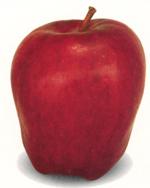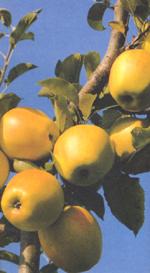| Fruits |
Vegetables
|
Apple, Malus domestica / Rosaceae
|
Note: Composition for 100 g. of fresh product Values in ( min. - max. ) format. | |
| Energy: 47.00-61.54 kcal Fats: 0.10-0.58 g Fibres: 1.80-2.20 g Minerals Calcium: 4.00-7.10 mgZinc: 0.100-0.103 mg Chlorine: 2.20-2.20 mg Phosporus: 6.07-12.00 mg Iron: 0.100-0.480 mg Magnesium: 5.00-6.40 mg Manganese: 0.030-0.100 mg Potasium: 116.00-144.00 mg Selenium: 1.38-1.38 µg Sodium: 3.00-6.00 mg Iodine: 1.08-3.90 µg | Proteins: 0.24-0.40 kcal Carbohidrates: 11.43-13.37 g Liposoluble Vitamins A Retinol: 0.00-4.33 µgA Carotenoids: 18.00-26.00 µg E or Tocoferol: 0.490-0.590 mg K or Filoquinone: 2.20-2.20 µg Liposoluble Vitamins B1 or Thiamine: 0.023-0.035 mgB2 or Riboflavine: 0.020-0.032 mg B3 or Niacine: 0.100-0.68 mg B5 or Pantothenic Acid: 0.100-0.100 mg B6 or Piridoxine: 0.060-0.103 mg B9 or Folic Acid: 1.32-12.00 mg C or Ascorbic Acid: 1.32-12.00 mg |
|
Note: Composition for 100 g. of fresh product Values in ( min. - max. ) format. | |
| Energy: 238.00-254.81 kcal Fats: 0.30-1.63 g Fibres: 9.70-10.07 g Minerals Calcium: 16.00-38.00 mgZinc: 0.50-0.50 mg Chlorine: 1.00-1.00 mg Phosporus: 33.00-50.00 mg Iron: 0.50-3.00 mg Magnesium: 16.00-16.00 mg Manganese: 0.50-0.50 mg Potasium: 540.00-622.00 mg Sodium: 10.00-16.00 mg | Proteins: 0.80-2.00 kcal Carbohidrates: 56.97-60.10 g Liposoluble Vitamins A Retinol: 0.00-0.00 µgA Carotenoids: 91.00-91.00 µg E or Tocoferol: 1.45-1.45 mg Liposoluble Vitamins B1 or Thiamine: 0.058-0.100 mgB2 or Riboflavine: 0.025-0.100 mg B3 or Niacine: 0.40-0.40 mg |

Apples are the ideal fruit to eat at any time, having a positive role in the achievement of nourish balance. Their skin may be green, yellow or reddish, and the meat taste ranges from a bitter to sweet flavour.
It is one of the most consumed fruit in the world. There is a great amount of varieties; thanks to that, apples are available all the year round.
It is one of the most consumed fruit in the world. There is a great amount of varieties; thanks to that, apples are available all the year round.
Nutrition and eating
Apples supply a great amount of vitamins and other nutrients to the human being, having multiple beneficial effects for health.
Their fibre content acts as a regulator in multiple intestinal disorders. If consumed raw, they are an excellent natural toothpaste that cleans and whitens the teeth, favouring the gums.
Their fibre content acts as a regulator in multiple intestinal disorders. If consumed raw, they are an excellent natural toothpaste that cleans and whitens the teeth, favouring the gums.
The fruit
 Apples are the ideal fruit to eat at any time, having a positive role in the achievement of nourish balance. Their skin may be green, yellow or reddish, and the meat taste ranges from a bitter to sweet flavour.
Apples are the ideal fruit to eat at any time, having a positive role in the achievement of nourish balance. Their skin may be green, yellow or reddish, and the meat taste ranges from a bitter to sweet flavour. It is one of the most consumed fruit in the world. There is a great amount of varieties; thanks to that, apples are available all the year round.
Apples are, along with bananas and citrus, one of the most consumed fruit in the world. In the N hemisphere they are, with no doubt, the fruit of which there exists more plantations.
In the United Kingdom, the consumption per person a week is 175 g (according to National Food Survey 1996, quoted in Fresh Produce Desk Book 1988), representing an annual consumption of 9.1 kg. The German magazine "Der Mark - Obst und Gemüse 8/2000 " shows a table with the consumption of apples per inhabitant a year in the last 5 years. During the periods 1995/96, 1996/97 and 1997/98 the consumption was, respectively, 19.5, 19.7 and 19.4. For 1998/99 the provisional data quoted is 20.2 and for 1999/2000 the forecast is 21,9. According to these data there is a slight increase in the European consumption.
The apple has the advantage that it is easy to consume as table dessert, between hours, in school, in the office... Furthermore, it does not unbalance any slimming diet since it has a very low caloric content, less than 100 kcal.
In botanics, this type of fruit is denominated pomo. It is characterised because in its formation, along with the seeds and the ovary, other parts of the flower take part. The central part is divided in five hollow compartments containing the seeds.
There exist multiple varieties of apples; they are distinguished by the shape of the fruit, rounded, elongate or flattened; by their colour, that varies from bright red to green; the colour of the pulp, its flavour - there are some apples in which sweetness predominates over acidity and some others, on the contrary, are very acid -; by the texture, that ranges from a very crisp to a mealy texture, although the latter may also be due to a storage problem; the period of maturation, the characteristics of the tree, suitability for storage, behaviour against diseases and pests, etc. Apples also defer in size, as much within the same variety as among varieties; the apples used for cooking are usually bigger than those for fresh consumption.
The period of harvest extends from the end of summer to the beginning of autumn, but apples are available all the year round thanks to their excellent storage characteristics- it can be stored for a long time if the appropriate techniques are applied. At present they are exported from the S Hemisphere. Apples may last up to 6 months if they are stored in normal air and up to 10 months under controlled atmosphere. Nowadays, the consumer confers a ‘value’ to ‘fresh’ produce; transport facilities make it possible to find, all the year round, apples that have not practically been kept in storage rooms.
Apples are consumed as table dessert, whole or as part of fruit salads; they are also cooked whole, in purées or stewed; they are used in confectionery, preserved as purée or jam, dehydrated and used to process juice, cider and vinegar.
The appropriate texture for apples consumed as dessert must be substantial and crisp and the taste must be preferably sweet, whereas apples intended for processing are usually more acid. Apples for cider may be more astringent.
The apple pulp contains up to 25% of air lodged in the spaces between the cells; during processing, this air must be removed in order to avoid the spoiling of the produce.
The plant

The apple tree is a small tree not exceeding 10 m high, although at commercial level they use smaller varieties in order to make the harvest and other culture processes much easier. They also have the advantage of sun exposure on the fruit, that is greater than in larger trees, and for that reason the quality of the produce is much better. In order to obtain smaller trees, they use dwarfing rootstocks.
The plant forms a globous crown and a straight trunk that may reach 2.5 m high. The oldest parts of the bark are scaly and of a greyish colour; on the contrary, the young branches are of an ash-grey colour with some greenish shades and small pores, called lenticels, that enable the gaseous interchange with the atmosphere.
The leaves are elliptical-shaped with sawed margins of obtuse teeth.
The showy flowers bloom some days before the leaves appear, conferring a showy appearance to the tree when it is completely bloomed. They gather in groups of 3 to 6 flowers, forming corymbs. They are hermaphrodite flowers, that is to say, one single flower has both sexes. The petals may be of a white to pale pink colour.
The average shelf life of an apple tree ranges from 60 and 80 years old, although the commercial plantations are reduced to half or even less.
The plant forms a globous crown and a straight trunk that may reach 2.5 m high. The oldest parts of the bark are scaly and of a greyish colour; on the contrary, the young branches are of an ash-grey colour with some greenish shades and small pores, called lenticels, that enable the gaseous interchange with the atmosphere.
The leaves are elliptical-shaped with sawed margins of obtuse teeth.
The showy flowers bloom some days before the leaves appear, conferring a showy appearance to the tree when it is completely bloomed. They gather in groups of 3 to 6 flowers, forming corymbs. They are hermaphrodite flowers, that is to say, one single flower has both sexes. The petals may be of a white to pale pink colour.
The average shelf life of an apple tree ranges from 60 and 80 years old, although the commercial plantations are reduced to half or even less.
| Interempresas Media, S.L. / 2025 | [ Legal notice | Política de Protección de Datos | Política de cookies | Publicidad] |
